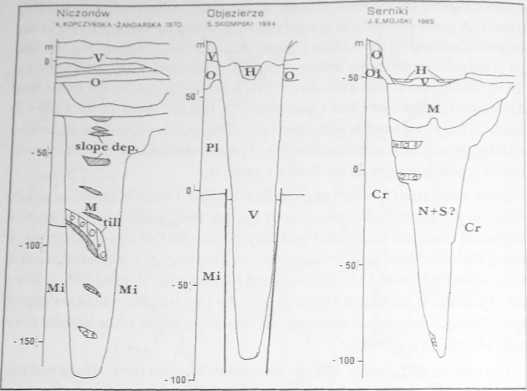DSC07868 (2)
36

Fig. 5. Cross-sections of the subglacial channels (Niczów in Pomerania Lakeland and Objezieize in Great Poland Lakeland), and Wieprz River valley, north of Lublin (simplified). Cr - Cretaceous, Ol - Oligocene, Mi - Miocene, N+S - Narewian and Sanian cold stages, M -Mazowian, O — Odranian, V — Vistulian, H - Holocene Przekroje subglacjalnych koryt rzecznych (Niczów na Pojezierzu i Objezierze w Wielkopolsce), dolina Wieprza, na północy Lublina (uproszczone). Cr—Kreda, Ol - Oligocen, Mi — Miocen, -fazy Narwi i Sanu, M - mazoweckie, O - odrzańskie, V - wistuliańskie, H - Holocen
In the Warsaw region it is rather impossible that the Mazowian bottom of the Vistula river occured at 30 m a.s.l. (Sarnacka 1982). A better propos-al is a conception (Lindner, Marks 1999), that the Vistula valley bottom occured at that time about 50 m a.s.l. Various proposals were put forward con-cerning the northern part of the Polish Plain. The latest of them has been described by Niewiarowski, Wysota (1996) and Lisicki (1998). The first sug-gestion maybe ruled out, because - 40 m b.s.l. in the vicinities of Lidzbark Warmiński, 100 km far from the Sztum Sea is distinctly too deep! The com-parison between the va!ue of 0-40 m a.s.l. at the Mazurian Lakeland and -20 m for Domnowo marinę beds is much closer, and therefore Lisicki’s (1998) proposal is morę reliable (Fig. 6).
The above, very briefly described example, conceming the Mazowian Vistula valley clearly shows the various difficulties with the palaeomorphic interpretation of interglacial fluvial valleys iii the Polish Plain, and also illus-trate the possible ways of solving them.
Wyszukiwarka
Podobne podstrony:
Przegląd Geologiczny, vol. 55, nr 12/1, 2007 Fig. S. Cross-section of the Borislav oil field (by Toł
Fig. 8 - Cross-sections of Orvieto Hill (For legenda see Fig.3) To conclude, the most important stab
Fig.l Cross-section of Chedi showing the three stages of construction around boreholes and laborator
152 J. Ohnishi et al. Fig. 3. Cross-sectional view of a newly designed sex-tupole magnet. X(cm) Fig.
67607 P1130021 1J Uterine structures in the marę 1.3.1 Non-pregnant uterus A sagittal cross section
13 shows the cross section of one of the pierś, P-4, consisting of 9 Steel pipę piles, each 3.5
24 JACEK LECH Fig. 27. Sąspów, Cracow dist. Cross section of shaft No 1 and portion of Shaft No 2 a
Simplified typical cross-section of a UV-LED structure(before electric contacts for the finał device
image001 A section of the wali rippcd boso and a solid, glassy column of wałor tmashed Haywood whera
image038 a Fig 10 Idea of the “World tree" as the “World axis" implemented m settlements o
Slajd56 Bielactwo Fig. 1.3-2.8 Bila te rai segmental vitiligo of the same distri>ution in Asian{a
Slajd66 Bielactwo - leczenie- terapia łączona_ Fig. 3.8.1 (a) Vitiljgo patehes of the face. (b) Glin
więcej podobnych podstron